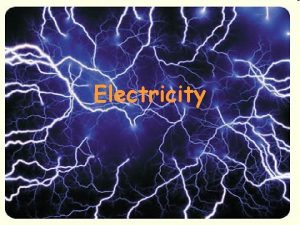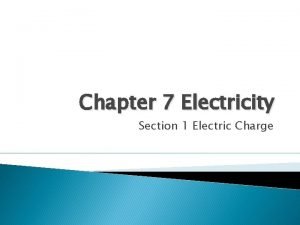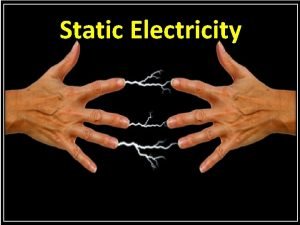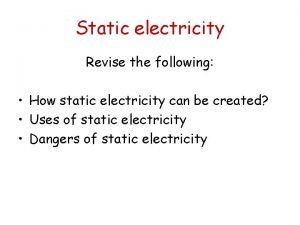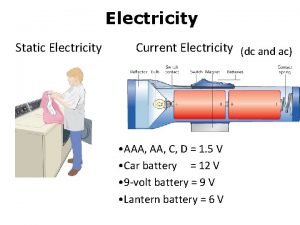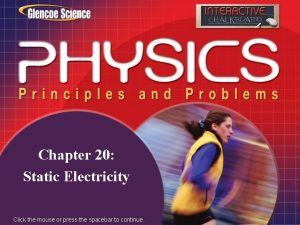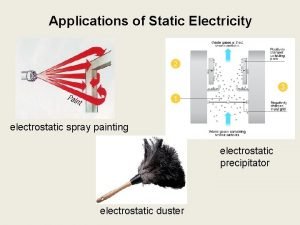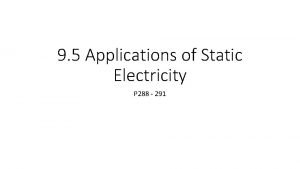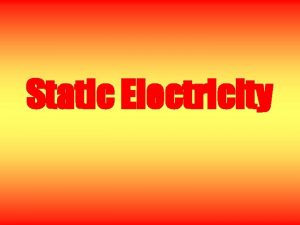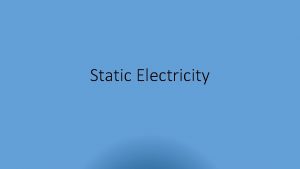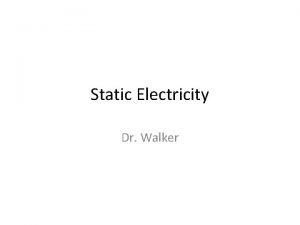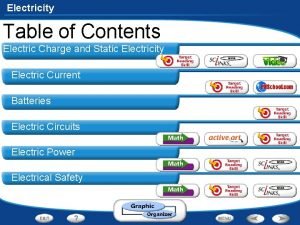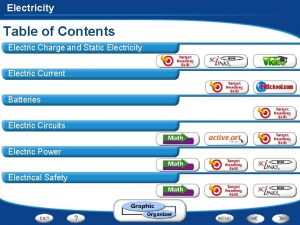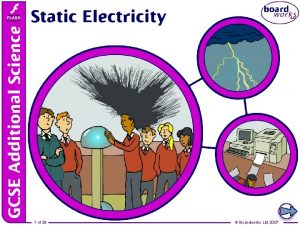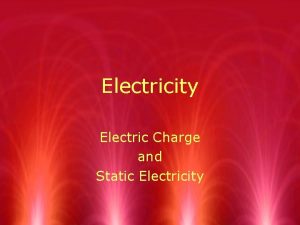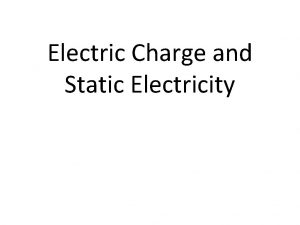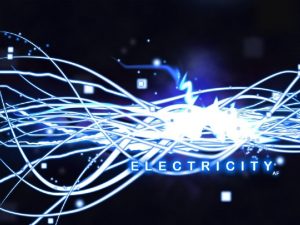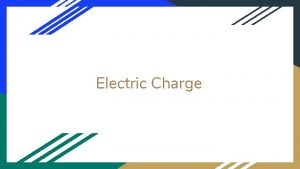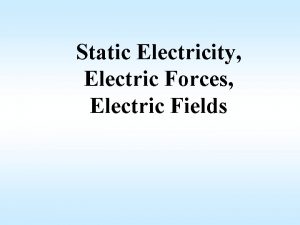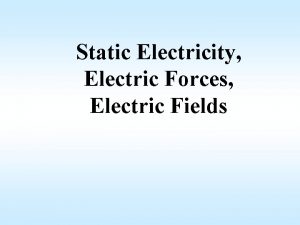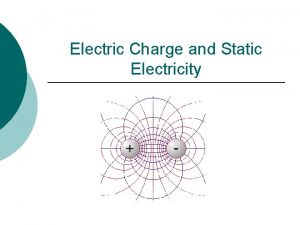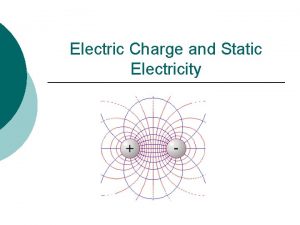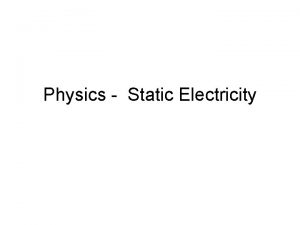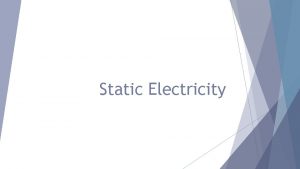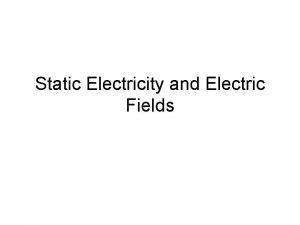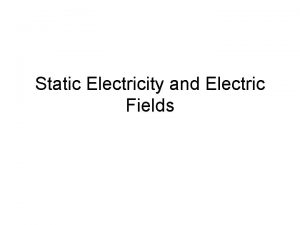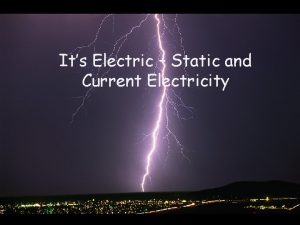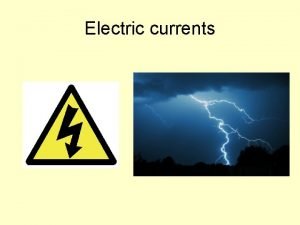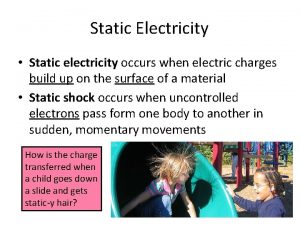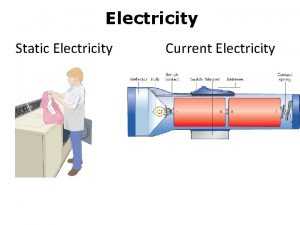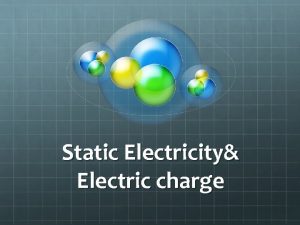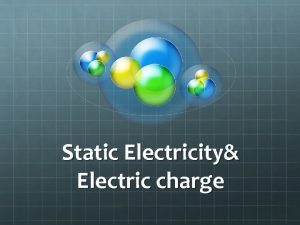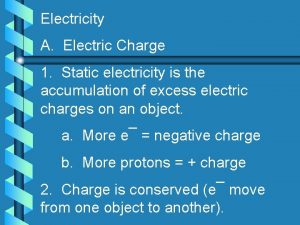Electric Charge and Static Electricity Electric Charge u


























- Slides: 26

Electric Charge and Static Electricity

Electric Charge u All matter is made up of atoms u Atoms contain 1. 2. 3. Protons (+) Neutrons (0) Electrons (-)

Law of Electric Charges u The law of electric charges states that like charges repel, and opposite charges attract. u Protons are positively charged and electrons are negatively charged, so they are attracted to each other. u Without this attraction, electrons would not be held in atoms.

Law of Electric Charges

Electric Force The force between the objects is an electric force. The size of the electric force depends on 2 things: 1. 2. The amount of charge (the greater the charge, the greater the force) The distance between charges (the further the distance, the less the force)

Coulomb’s Law Gives the electric force between two point charges. Inverse Square Law u k = Coulomb’s Constant = 9. 0 × 109 Nm 2/C 2 u q 1 = charge on mass 1 u q 2 = charge on mass 2 u r = the distance between the two charges The electric force is much stronger than the gravitational force.

Example 1 Two charges are separated by a distance r and have an electric force on each other. q 2 q 1 r u If r is doubled then is: u If q 1 and q 2 are doubled and r is halved then is:

Example 2 Two 40 gram masses each with a charge of 3μC are placed 50 cm apart. Compare the gravitational force between the two masses to the electric force between the two masses. Ignore the force of the earth on the two masses.

Electric Field An electric field is the region around a charged object where electric forces can be exerted on another charged object. (Repelled or attracted)

Charged Objects Atoms do not have a charge because the number of electrons and protons cancel each other out. For example: 3 protons (+) & 3 electrons (-) = 0

Charged Objects How do objects get charged? u They either gain or lose electrons. u Why not protons? For example: 3 protons (+) & 5 electrons (-) = 7 protons (+) & 2 electrons (-) =

How Can You Charge Objects? There are 3 ways objects can be charged: 1. Friction 2. Conduction 3. Induction **In each of these, only the electrons move. The protons stay in the nucleus**

Charging by Friction Charging by friction occurs when electrons are “wiped” from one object onto another. For example: If you use a cloth to rub a plastic ruler electrons move from the cloth to the ruler. The ruler gains electrons and the cloth loses electrons.

Charging by Conduction Charging by conduction happens when electrons move from one object to another through direct contact. For example: Suppose you touch an uncharged piece of metal with a positively charged glass rod. Electrons from the metal will move to the glass rod. The metal loses electrons and becomes positively charged.

Charging by Induction Charging by induction happens when charges in an uncharged object are rearranged without direct contact with a charged object. For example: If you charge up a balloon through friction and place the balloon near pieces of paper, the charges of the paper will be rearranged and the paper will be attracted to the balloon.

Conservation of Charge When you charge something by any method, no charges are created or destroyed. The numbers of electrons and protons stay the same. Electrons simply move from one atom to another, which makes areas that have different charges.

Conductors and Insulators u An electrical conductor is a material in which charges can move easily. u Most metals are good conductors because some of their electrons are free to move. u Conductors are used to make wires. For example, a lamp cord has metal wire and metal prongs. u Copper, aluminum, and mercury are good conductors.

Conductors and Insulators u An electrical insulator is a material in which charges cannot move easily. u Insulators do not conduct charges very well because their electrons cannot flow freely. The electrons are tightly held in the atoms of the insulator. u The insulating material in a lamp cord stops charges from leaving the wire and protects you from electric shock. u Plastic, rubber, glass, wood, and air are good insulators.

Static Electricity u Static electricity is the electric charge at rest on an object. u When something is static, it is not moving. u The charges of static electricity do not move away from the object that they are in. So, the object keeps its charge. u For example: Clothes taken out of a dryer

Electric Discharge The loss of static electricity as charges move off an object is called electric discharge. Sometimes, electric discharge happens slowly. For example: Static on clothes. Sometimes, electric discharge happens quickly. For example: Wearing rubbersoled shoes on carpet and lightning.

What Causes Lightning? u u u Lightning is actually just static electricity on a much larger scale. The rubbing is caused by air moving around. In thunderclouds bottom is usually negative and top is positive.

How Lightning Forms

Lightning usually strikes the highest point in a charged area because that point provides the shortest path for the charges to reach the ground. u Anything that sticks up or out in an area can provide a path for lightning. u A lightning rod is a pointed rod connected to the ground by a wire. u Objects, such as a lightning rod, that are joined to Earth by a conductor, such as a wire, are “grounded. ” Any object that is grounded provides a path for electric charges to move to Earth. u Because Earth is so large, it can give up or absorb charges without being damaged. u When lightning strikes a lightning rod, the electric charges are carried safely to Earth through the rod’s wire. By directing the charge to Earth, the rods prevent lightning from damaging buildings.

Thunder u When the lightning flash happens it heats the air to a temperature 5 times hotter than the surface of the sun. u This causes nearby air to expand vibrate forming the sound we hear as thunder.

Interesting Facts u Lightning bolts can travel at speeds of up to 60 000 miles per second. u Every second around 100 bolts of lightning strike the Earth. u One lightning bolt has enough electricity to power 200 000 homes. u You are more likely to be struck by lightning than be eaten by a shark.

Some Myths u Lightning never strikes in the same place twice. u u False, the Empire State Building is reportedly struck 100 times a year. Wearing rubber shoes will protect me in a thunder storm. u False, lighting is too powerful to be stopped by half an inch of rubber or several hundred feet of rubber for that matter.
 Static electricity and current electricity
Static electricity and current electricity Electricity n
Electricity n How are static electricity and current electricity alike
How are static electricity and current electricity alike Chapter 6 section 1 electric charge worksheet answers
Chapter 6 section 1 electric charge worksheet answers Section 1 electric charge crossword puzzle answers
Section 1 electric charge crossword puzzle answers Electricity section 1 electric charge
Electricity section 1 electric charge Difference between charge and electric charge
Difference between charge and electric charge Electrons flowing
Electrons flowing Chapter 21 electric charge and electric field
Chapter 21 electric charge and electric field Chapter 21 electric charge and electric field
Chapter 21 electric charge and electric field Electric field k constant
Electric field k constant Units of a charge
Units of a charge Electricity flow
Electricity flow Static electricity painting
Static electricity painting Bill nye static electricity worksheet
Bill nye static electricity worksheet How was electricity discovered
How was electricity discovered Electric current
Electric current Static electricity chapter 20 answers
Static electricity chapter 20 answers Static electricity painting
Static electricity painting Static electricity painting
Static electricity painting Stationary electric charge
Stationary electric charge Static electricity examples
Static electricity examples Electrostatic equilibrium
Electrostatic equilibrium Graphic organizer 1 electric current
Graphic organizer 1 electric current Static electricity
Static electricity Static electricity summary
Static electricity summary Static electricity
Static electricity




